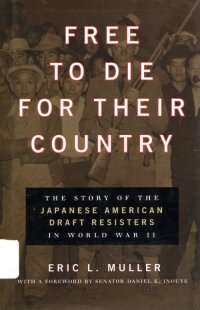
Free to Die For Their Country: The Story of the Japanese American Draft Resisters in World War II

Eric L. Muller, 2001
It starts off quite interesting since the author is Jewish and the son of German immigrants who had to flee Nazi Germany. After they settled here and the war started, though, they were relisted as "enemy aliens," their farm searched and they were prohibited from traveling more than five miles from their farm.
The author talks about the drafting of the Nisei and how they faced a terrible choice; either they fight against the country of their ancestry or they refused and became subject to prosecution. They were behind barbed wire, held prisoners by the U.S. because of their ancestry and yet, at the same time, they were expected to be willing to join the U.S. military and fight against Japan. How many people would be expected to agree to fight for a country that had you and your family locked up in a prison camp simply because you had relatives that were born in a country the U.S. was at war with, even though you, yourself, were a full-blown U.S. citizen?
It's fairly easy to see why some refused to be drafted.
More than 300 Japanese from the ten camps became draft resisters. They were arrested and tried in 1944 and almost without exception were found guilty and sentenced to prison terms of two to five years. The author goes into the history of the JACL also. Then he talks about individual reactions to Pearl Harbor and the FBI crackdown on the Nisei and Issei.
Next the author discusses the curfew, the assembly centers and then the relocation centers. On Feb. 1, 1943, FDR announced that a segregated combat unit would be formed for the Nisei. What is significant is that the government wanted the Nisei to start volunteering while they had basically just a short time before had removed the Nisei from the military or put them into dead-end type jobs. So not only did the Nisei have to consider that they were behind barbed wire but the government that originally didn't even want them in the military suddenly expected them to be gung-ho for getting into the military.
The military actually expected that about one of every three male Nisei (of proper age) in the camps would be willing to volunteer. This is, of course, when they decide to come up with the infamous loyalty questionnaire that just caused even more trouble about the Nisei.
The situations at the different camps is talked about including some trouble at the Tule Lake center. Then matters worsened when the volunteer movement didn't get as many volunteers as the military wanted so they said they would start drafting the Nisei.
Again, the author examines what happened at some of the camps, especially in relation to those who refused to report for duty. The government was also threatening those who defied the military with imprisonment. The author also deals with specific people rather than just general numbers.
The types of tactics that the government used to try to silence and control the resisters are, in general, quite disgusting and do not make for pleasant reading.
The trial of 63 resisters from Heart Mountain is talked about, especially the part where the judge referred to the defendants as "you Jap boys." Not saying much for fairness or impartiality. (Apparently the judge didn't care much for blacks or Jews, either.)
The various trials the resisters from various camps underwent is discussed in considerable detail. It follows this with a discussion of the prisons the men were sent to when they were found guilty.
For anyone interested in the legal aspects of the draft resistance movement, what led up to it and its aftermath, this is an excellent book to read.
The book notes that even many of the lawyers hired to defend the young men did not like persons of Japanese ancestry and would take little if any part at all in their actual defense.
Main Index
Japan main page
Japanese-American Internment Camps index page
Japan and World War II index page
|